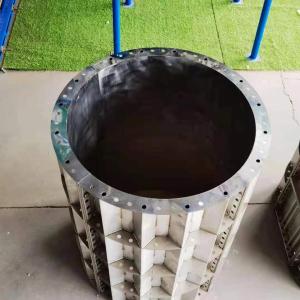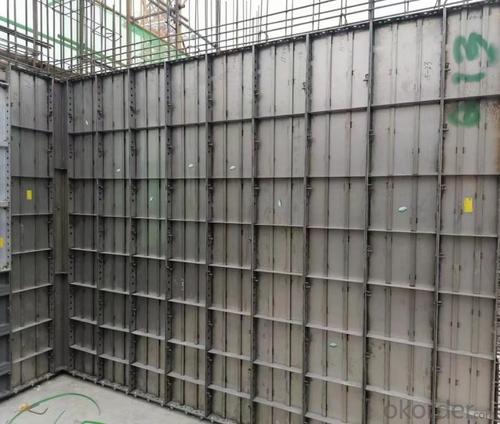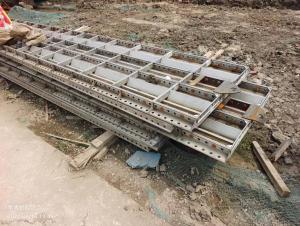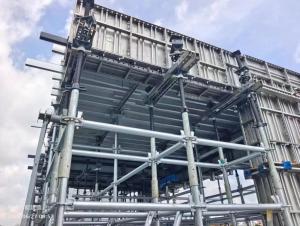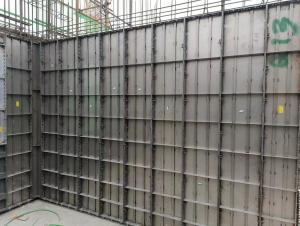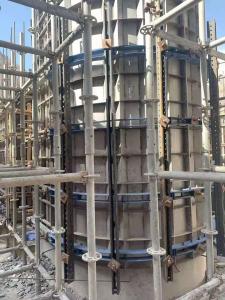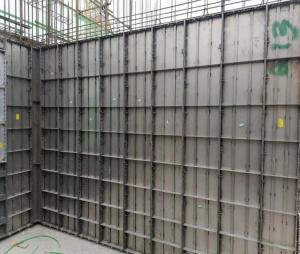Hot seller-steel formwork for concrete,concrete column formwork , Stainless Steel Formwork
- Loading Port:
- Shanghai
- Payment Terms:
- TT or LC
- Min Order Qty:
- 1 set
- Supply Capability:
- 1000000 set/month
OKorder Service Pledge
OKorder Financial Service
You Might Also Like
Stainless steel formwork
Replaceable size aluminum formwork :400X1200mm , 400X1500mm
PRODUCT CHARACTERISTICS
Stainless steel side profiles
80kn/M2 maximum pressure
3 different heights; 1.2m, 2.7m and 3.3m
suitable to be used on any site where circular walls need to be poured. Adjusting the radii is easy and simple, making Conflex a cost-effective system.
Advantages:
1 Stainless steel formwork, 100% follow the design of aluminum alloy formwork system, it is interchangeable, compatible and can be used together with aluminum formwork at the same time .
2It is made of high-strength stainless steel strip by rolling and laser welding. It has good corrosion resistance and high density,is not easy to rust and has no fire hazard.
3Long service life, many turnover times, high recycling value
The number of turnovers is large, especially the characteristics of no dust, no need to brush or less mold release agent, and the characteristics of low renovation costs will bring unlimited optimistic prospects to it.

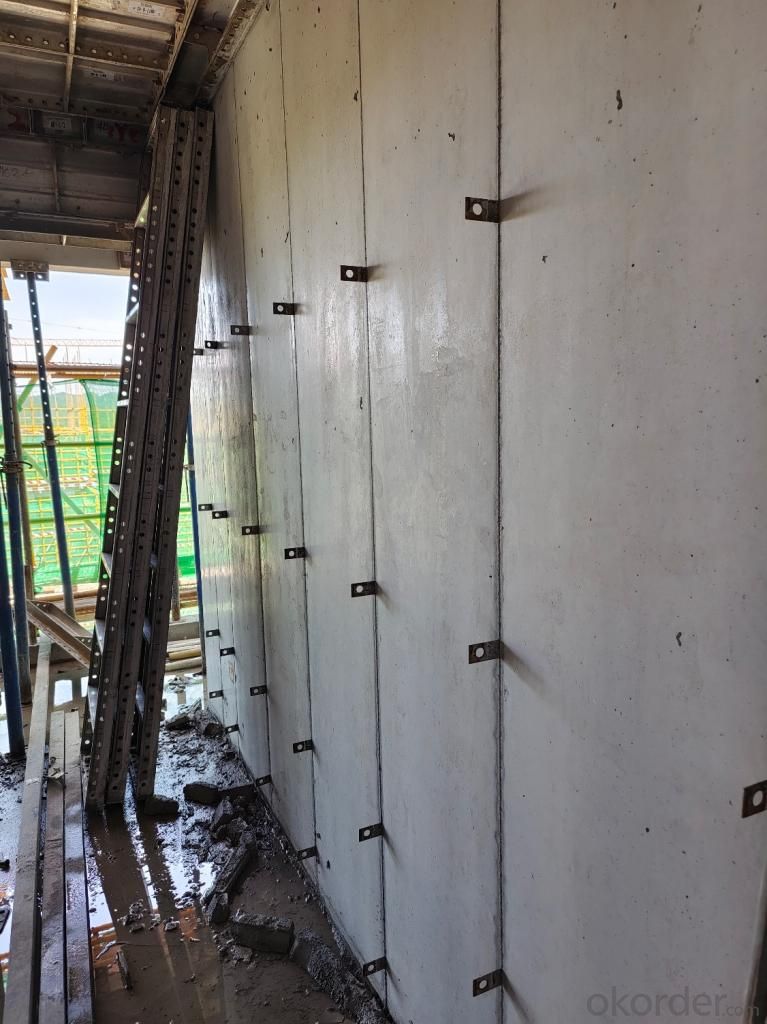
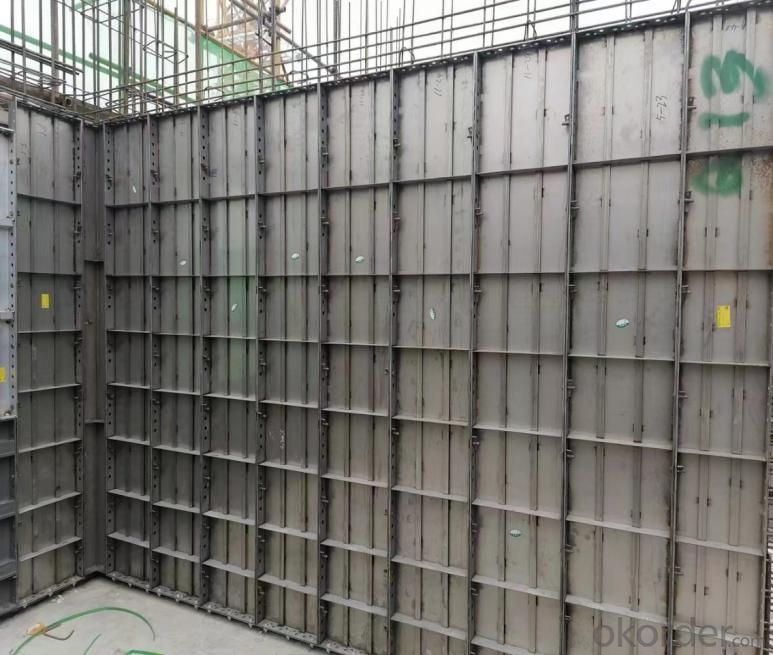
- Q: What are the different types of accessories used with steel formwork?
- There are various types of accessories that are commonly used with steel formwork to enhance its functionality and effectiveness in construction projects. Some of the different types of accessories used with steel formwork include: 1. Formwork Wedges: These are small wedges made of steel or plastic that are used to secure the formwork panels together. They help in maintaining the accurate alignment and stability of the formwork system during concrete pouring. 2. Formwork Clamps: Clamps are used to hold the formwork panels in place and prevent any movement or displacement during the pouring and curing of concrete. They are typically made of steel and are available in different sizes and designs to suit various formwork requirements. 3. Formwork Ties: Ties are used to connect the formwork panels and provide structural stability to the formwork system. They can be either steel or plastic and are available in different lengths and types, such as snap ties, wedge ties, and loop ties. 4. Formwork Braces: Braces are used to reinforce and strengthen the formwork system. They are typically made of steel and are used to support the formwork panels and prevent any bending or deformation during the concrete pouring process. 5. Formwork Hangers: Hangers are used to suspend the formwork panels at the desired height and provide support. They are typically made of steel and are adjustable to accommodate different formwork heights and configurations. 6. Formwork Spacers: Spacers are used to maintain the desired spacing between the formwork panels and ensure uniformity in the thickness of the concrete walls or slabs. They are typically made of plastic or steel and are available in various sizes and shapes. 7. Formwork Release Agents: Release agents are used to prevent the adhesion of concrete to the formwork surface. They are applied to the formwork panels before the concrete is poured, allowing for easy removal of the formwork once the concrete has cured. Overall, these accessories play a crucial role in ensuring the stability, alignment, and functionality of steel formwork systems. They contribute to the efficiency and quality of construction projects by providing reliable support and reinforcement to the formwork during the concrete pouring process.
- Q: What are the different surface finishes available for steel formwork?
- There are several different surface finishes available for steel formwork, depending on the specific requirements and preferences of the project. 1. Smooth finish: This is the most common surface finish for steel formwork. It involves grinding or sanding the surface to create a smooth and even appearance. Smooth finishes are ideal for projects that require a high level of precision and aesthetic appeal. 2. Textured finish: Some projects may require a textured surface finish for better bonding with concrete. This can be achieved through various methods, such as shot blasting or using textured form liners. Textured finishes provide additional grip and can enhance the bond between the formwork and concrete. 3. Brushed finish: Brushed finishes involve using wire brushes or abrasive pads to create a slightly rougher surface. This finish is often chosen for applications where slip resistance is important, such as on ramps or walkways. 4. Etched finish: Etching is a chemical process that creates a matte or patterned finish on steel formwork. This finish is commonly used for decorative purposes, as it can create unique designs or patterns on the surface. 5. Galvanized finish: Galvanizing is a coating process that involves applying a layer of zinc to the steel formwork. This finish provides excellent corrosion resistance, making it suitable for projects in harsh or corrosive environments, such as marine or industrial applications. 6. Powder-coated finish: Powder coating is a durable and decorative finish that involves applying a dry powder to the steel formwork and then curing it with heat. This finish is available in a wide range of colors and provides excellent resistance to impact, chemicals, and UV radiation. It's important to consider the specific requirements of the project, such as durability, aesthetics, and environmental conditions, when selecting the appropriate surface finish for steel formwork. Consulting with a structural engineer or formwork supplier can help determine the best finish for the intended application.
- Q: How does steel formwork prevent concrete shrinkage and cracking?
- The use of steel formwork is essential in preventing concrete shrinkage and cracking. By offering robust and rigid support during the curing process, it ensures that the concrete retains its shape and hardens properly. Acting as a mold, the steel formwork securely holds the concrete in place, preventing any shrinkage or cracking as it dries. Concrete shrinkage and cracking are primarily caused by the loss of moisture during curing. As the water evaporates from the concrete, it causes the material to shrink, potentially leading to cracks if not adequately supported. To prevent this shrinkage, steel formwork provides a tight enclosure for the concrete, ensuring that it retains its moisture and doesn't dry out too quickly. This controlled drying process allows for even curing, minimizing the risk of shrinkage and cracking. Moreover, steel formwork provides stability and support to the concrete, preventing any movement or shifting as it hardens. This stability helps distribute forces and stresses evenly, reducing the likelihood of cracking or structural failure. Furthermore, the smooth and rigid surface of steel formwork contributes to achieving a high-quality finish on the concrete. This eliminates any irregularities or imperfections that may weaken the structure or make it more susceptible to cracking. In conclusion, steel formwork is vital in preventing concrete shrinkage and cracking by offering support, stability, and moisture retention during the curing process. Its strong and rigid structure ensures the integrity of the concrete and enhances its durability, reducing the risk of structural issues.
- Q: Can steel formwork be used in areas with high wind uplift forces?
- Yes, steel formwork can be used in areas with high wind uplift forces. Steel is a strong and durable material that can withstand high wind forces, making it suitable for use in such areas. Additionally, the rigid and stable nature of steel formwork provides added strength and stability, ensuring the structure remains intact even under extreme wind conditions.
- Q: Can steel formwork be used in retail or commercial construction projects?
- Yes, steel formwork can be used in retail or commercial construction projects. Steel formwork is a versatile and durable solution for creating concrete structures in construction projects. It offers several advantages such as high reusability, excellent dimensional stability, and the ability to handle high concrete pressures. In retail or commercial construction projects, steel formwork can be used for various applications such as constructing columns, walls, beams, slabs, and staircases. It provides a sturdy framework that ensures accurate and smooth concrete placement, resulting in high-quality finishes. Additionally, steel formwork can be easily customized and adjusted to suit different project requirements, making it suitable for projects with complex architectural designs. Furthermore, steel formwork offers significant time and cost savings in construction projects. Its reusability reduces the need for frequent formwork replacements, resulting in reduced material and labor costs. The use of steel formwork also enhances construction efficiency, as it allows for faster assembly, disassembly, and repositioning of formwork components. Overall, steel formwork is a reliable and efficient choice for retail or commercial construction projects, providing the necessary strength and flexibility required for such applications.
- Q: How does steel formwork handle reinforcement placement?
- Steel formwork handles reinforcement placement by providing a rigid and sturdy structure that holds the reinforcement bars in place during the concrete pouring process. The formwork is designed with pre-determined spaces and supports to accurately position the reinforcement bars in the desired locations as per the structural drawings. This ensures that the reinforcement is properly aligned and secured before the concrete is poured, resulting in a strong and durable structure.
- Q: How does steel formwork contribute to faster construction?
- Steel formwork contributes to faster construction by offering several advantages over traditional wooden formwork. Firstly, steel formwork is highly durable and can withstand multiple uses, resulting in reduced downtime and increased productivity. Additionally, its robustness allows for faster assembly and disassembly, enabling quicker turnaround times between construction projects. The precision and accuracy of steel formwork also ensure consistent and high-quality concrete finishes, reducing the need for additional finishing work. Moreover, steel formwork is highly adaptable and can be easily modified or customized to accommodate various building designs, facilitating faster construction processes. Overall, the use of steel formwork accelerates construction timelines and enhances efficiency, thereby contributing to faster project completion.
- Q: How does steel formwork affect the overall construction budget?
- Steel formwork can have a significant impact on the overall construction budget. While it may initially have a higher upfront cost compared to other types of formwork, such as timber or plastic, it offers various advantages that can result in cost savings in the long run. One major advantage of steel formwork is its durability and reusability. Unlike timber or plastic formwork, steel formwork can withstand multiple uses without compromising its structural integrity. This means that it can be used for numerous construction projects, reducing the need for frequent replacements and lowering material costs over time. Additionally, steel formwork is known for its high strength and stability, allowing for efficient concrete pouring and ensuring precise and accurate dimensions. This reduces the risk of errors or reworks, which can lead to significant time and cost overruns. Furthermore, steel formwork typically requires less labor and time to assemble and dismantle compared to traditional formwork materials. Its modular design and ease of installation enable quicker construction progress, resulting in reduced labor costs and improved project efficiency. Moreover, steel formwork offers flexibility in design and customization, allowing for complex and intricate structures to be built with ease. This versatility can eliminate the need for additional materials or specialized formwork systems, resulting in cost savings. In summary, while steel formwork may have a higher initial cost, its durability, reusability, strength, and efficiency can lead to cost savings in terms of material, labor, and time. By considering the long-term benefits and overall efficiency it provides, steel formwork can positively impact the overall construction budget.
- Q: How does steel formwork affect the concrete pouring process?
- Steel formwork plays a crucial role in the concrete pouring process by providing a sturdy and reliable support structure for the wet concrete. It offers several advantages over other types of formwork, such as timber or plastic. Firstly, steel formwork is highly durable and can withstand the pressure exerted by the wet concrete without warping or deforming. This ensures that the formwork maintains its shape and dimensions, resulting in a finished concrete structure that is accurate and precise. This is particularly important for projects with complex shapes or intricate designs. Additionally, steel formwork is reusable, making it a cost-effective solution for construction projects. Unlike timber or plastic formwork, steel can be used multiple times, reducing the overall project expenses. It also contributes to sustainability by minimizing waste and reducing the environmental impact associated with disposable formwork materials. Another advantage of steel formwork is its ability to provide a smooth surface finish to the concrete. The steel panels are manufactured with high precision, resulting in a uniform and even surface texture on the poured concrete. This is particularly beneficial for projects that require a high-quality finish, such as architectural structures or exposed concrete surfaces. Furthermore, steel formwork offers excellent stability and support during the pouring process. Its rigid structure prevents any movement or shifting of the formwork, ensuring that the concrete is poured accurately and evenly. This is crucial for maintaining the structural integrity of the concrete and preventing any potential defects or weaknesses. In summary, steel formwork significantly affects the concrete pouring process by providing durability, reusability, smooth surface finish, and stability. It ensures that the concrete structure is formed accurately and precisely, resulting in a high-quality finished product.
- Q: How does steel formwork contribute to easier formwork removal?
- Steel formwork offers several advantages that contribute to easier formwork removal. Firstly, its high strength and durability enable it to withstand the pressure and weight of the concrete without deforming or warping. As a result, the formwork remains undamaged and intact after the concrete is poured and cured. Secondly, the smooth surfaces of steel formwork facilitate the easy release of the cured concrete. The absence of sticking between the concrete and the formwork simplifies the removal process, especially when dealing with complex shapes and intricate designs. Consequently, the formwork can be removed effortlessly without causing any harm to the concrete. Moreover, steel formwork often incorporates detachable parts or panels, allowing for convenient assembly and disassembly. This feature not only speeds up the removal process but also simplifies the cleaning and maintenance of the formwork. Consequently, the formwork remains in good condition, ensuring its longevity and reusability. Additionally, steel formwork exhibits remarkable resistance to moisture and chemicals commonly encountered in the construction environment. This resistance prevents the formwork from deteriorating or weakening over time. Consequently, the formwork remains intact and in excellent condition, making it easier to remove after the concrete has set. In summary, the strength, durability, smooth surfaces, detachable parts, and resistance to moisture and chemicals make steel formwork an ideal choice for easier formwork removal. This not only simplifies the process but also guarantees the quality and integrity of the concrete structure being constructed.
Send your message to us
Hot seller-steel formwork for concrete,concrete column formwork , Stainless Steel Formwork
- Loading Port:
- Shanghai
- Payment Terms:
- TT or LC
- Min Order Qty:
- 1 set
- Supply Capability:
- 1000000 set/month
OKorder Service Pledge
OKorder Financial Service
Similar products
Hot products
Hot Searches

